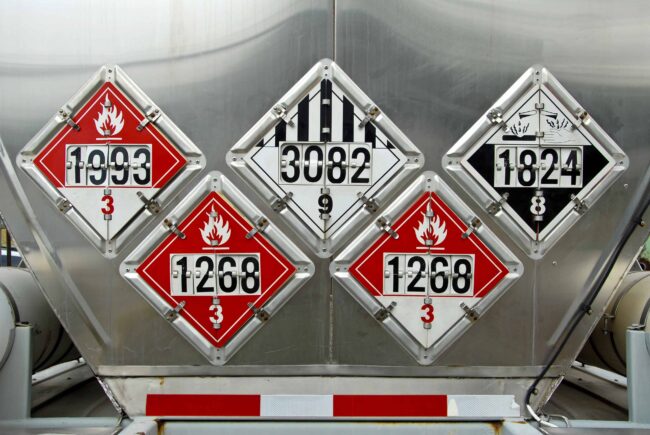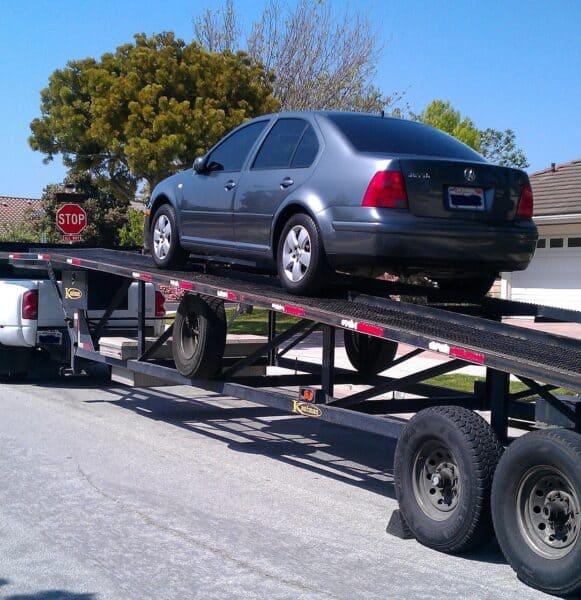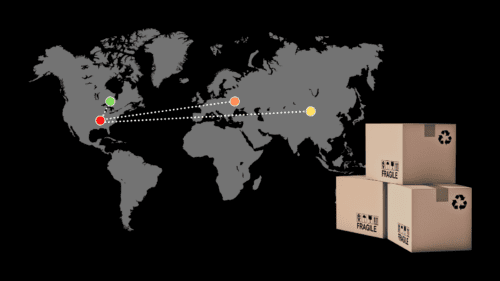Climbing prices and a semiconductor shortage mean more people are buying used vehicles from around the country, and they’re now asking how to ship a car to their home. It’s a straightforward question with a fascinating answer, especially if you’re into logistics and fulfillment. Some carriers specialize in shipping cars in most countries, making it easier to get one from the next town, the next state, or even another country.
In this post, we’ll look at how to ship a car across the ocean and land, different trailer options, what can increase your cost, and how to prep a car you own before shipping. Buckle up.
Doors, docks, and terminals
In the U.S., most consumer car shipping happens “door-to-door” when possible. This technique has the carrier bring a specific vehicle from the seller’s inventory location direct to the buyer’s home. There are “terminal-to-terminal” services that offer more flexible drop-off and pick-up. Here, a car is picked up from one regional storage location and shipped to another, where the carrier can store vehicles for longer periods. These moves are standard when shipping a car to someone who is moving a long distance.
Those terminal-based moves may also include transit across ports and different loading docks for international moves. Typically, this will involve a vehicle traveling from one terminal to a port by rail or truck. Vehicles are loaded onto ocean carriers, brought to a new port, and then unloaded similarly.
Whether you’re buying or selling the vehicle, you want an assurance that this is possible before the move starts. There can be various reasons a carrier may refuse to deliver or can’t make a specific drop-off location. Still, they and your logistics partner typically can determine this before you try to ship a car itself.
You can also ship a car via air freight. However, this is awfully expensive and often reserved for luxury or antique cars. So, we’re not diving into greater detail about this uncommon method to ship a car.
How to ship a car by truck
For most of us, a tractor-trailer comes to mind when thinking about how to ship a car. These large trucks generally carry eight to 12 vehicles on a special trailer with two levels. However, smaller options may only carry a few vehicles, or you might have a single car on a flatbed trailer when someone hires a company to move that vehicle for the.
Nearly all cars are shipped on open trailers because this is a safe and affordable option. Open trailers can fit more vehicles simultaneously, spreading out the carrier’s cost across more vehicles or customers. You can, though, also choose an enclosed trailer to ship a car. Enclosed trailers are standard for luxury, antique, racing, and other high-end vehicles. An enclosed trailer limits the vehicle’s exposure to the Sun and weather.
Some local ordinances will restrict where oversized vehicles can travel. The trucks that are used to deliver a car also need a lot of room to maneuver. These and other restrictions may mean that the customer can’t always have the vehicle delivered directly to their home. In those cases, carriers will provide a general pickup location for buyers. Sometimes that is at a car dealership, while other times it can be a lot the carrier owns or leases.
How to ship a car by rail
The bulk of today’s vehicle shipments (about 70% by some estimates) in the U.S. involve at least some travel on a train. These journeys are usually from production facilities that have their own rail connection or imports coming from ports. Going by rail makes the longer travel more affordable, and it allows companies to ship to auto dealers and individuals more easily.
If you ever see these train cars pass by, you’ll be looking at up to 800 vehicles traveling on a special train and using special cars. Autorack cars have up to three decks and can carry as many as 20 vehicles. They’ll have three racks when carrying coups and sedans, two racks for SUVs and large trucks, and only a single rack for moving things like military vehicles.
How to ship a car by sea
Many thousands are traveling on the ocean as you read this, no matter the time of year. Most of these vehicles come from manufacturers exporting cars to more lucrative sales markets. However, a few are moving for individuals, either as part of a sale or when the person is relocating. While the ocean journey can be long, the most critical aspects of how to ship a car by sea bookend that voyage.
Vehicles shipped by sea are usually placed directly into shipping containers. A container can hold up to four standard vehicles. Oversized vehicles, like buses and RVs, are loaded via RoRo (roll-on, roll-off) services. A vehicle must be able to run and drive if it requires the RoRo service.
Cars are often re-measured at the port. You may see a price increase compared to your estimate because the ocean carrier relies on port measurements.
When you’re shipping a car via the ocean, the seller or owner needs extensive documentation about the vehicle. This extends beyond typical freight documents, such as the bill of lading, to the registration, title, inspections, and more. You’ll need three copies of these documents, each notarized. If you have a car loan or it’s a lease, you need notarized documents from the lender or owner that gives their permission for the car to be exported from the country of origin.
Given the wide range of documents, costs, potential port fees, duties, and more, it’s always recommended to discuss your move with multiple companies that specialize in shipping cars.
Hazardous materials and more

Gasoline and car batteries are generally considered hazardous materials. However, when shipping them inside a vehicle, you avoid many related regulations for shipping them. The carrier moving your vehicle will want to ensure that your car isn’t leaking gas and that the battery is attached correctly and clean. But you can ship your car with these items and not have to worry about draining the tank or removing the battery for storage.
Check with your carrier about gasoline requirements for shipping a vehicle. Some will mandate at least ¼ of a tank so that the vehicle can be driven off and on platforms during loading/unloading. Ask the carrier for a minimum gasoline amount. Get gas levels as close as possible to avoid shipping (and paying for) the added weight of a full tank.
There are also some hazardous material concerns specific to each carrier. If the carrier feels that your vehicle is not safe, it will likely not move the vehicle for you. Generally, this occurs when a vehicle is severely damaged or does not run. That concern typically covers elements like leaking fluids or damage that would be made worse during any transit. However, custom modifications or excessive weight may also make the car impractical to move, and carriers have the discretion to deny transportation.
Prepping the car itself
If you’re thinking about how to ship a car yourself, ask multiple carriers for their vehicle requirements. Many offer a checklist to help you prepare the vehicle for transport. There are a few consistent prep action items beyond the documentation mentioned above:
- Clean your car inside and out
- Remove anything beyond installed equipment
- Take photos of the entire outside to help you monitor for in-transit damage
- Write a list of any cosmetic damage, including rust
- Provide your photos and list to the carrier and get a verification of it
- Charge the battery
- Inflate your tires
- Locate your spare set of keys. Carriers will move the car at different points
- Disable the car alarm — carriers and truck drivers will disable alarms that go off during transit and may not be so gentle if your car is the one going off every few minutes
The last piece of advice is to remove toll tags and related parking items. They can be a target for theft, and some people report their E-ZPasses getting scanned during transit, leading to a surprise toll.
What can make it cost even more?
Like any good fulfillment operation, costs to ship a car vary. The most surprising element might be that the time of year impacts your cost. That’s because the price considers traffic flow along the route. Cars moving south between two destinations often face higher charges in the winter than cars going north. That’s because there’s more traffic, slowdowns, and delays as people try to escape the cold weather.
Here are a few items that can impact the cost of shipping a car:
- Most companies apply a flat pick-up and drop-off fee for the driver’s labor, but these can vary
- The further you travel, the more expensive it is.
- Open trailers can cost up to 40% less than enclosed trailers
- Costs tend to go up as the vehicles size and weight increase
- Custom and modified vehicles generally have a surcharge
- The vehicle is expensive and requires greater insurance coverage
- The vehicle is inoperable and may need towing or special equipment
- If a route is more complicated or involves going across narrow or slower roads, you may see a cost increase
Ready to ship something else?
Thinking about how to ship a car is pretty interesting, but it’s only the beginning. Want to continue your mental road trip? We’re here to help. Here’s how to ship some other amazing products:
And if you sell cars or car parts, learn more about how we can help.














